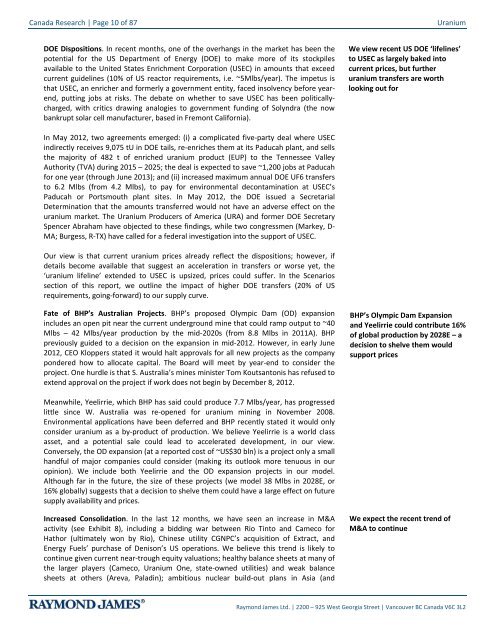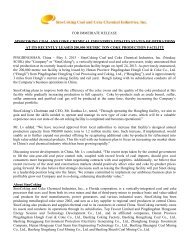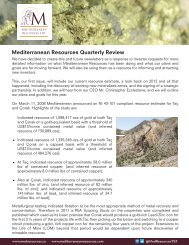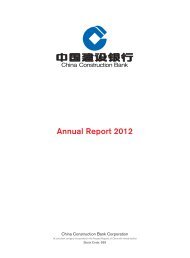Clock - Uranium Supply Crunch and Critical ... - Andrew Johns
Clock - Uranium Supply Crunch and Critical ... - Andrew Johns
Clock - Uranium Supply Crunch and Critical ... - Andrew Johns
- No tags were found...
Create successful ePaper yourself
Turn your PDF publications into a flip-book with our unique Google optimized e-Paper software.
Canada Research | Page 10 of 87<strong>Uranium</strong>DOE Dispositions. In recent months, one of the overhangs in the market has been thepotential for the US Department of Energy (DOE) to make more of its stockpilesavailable to the United States Enrichment Corporation (USEC) in amounts that exceedcurrent guidelines (10% of US reactor requirements, i.e. ~5Mlbs/year). The impetus isthat USEC, an enricher <strong>and</strong> formerly a government entity, faced insolvency before yearend,putting jobs at risks. The debate on whether to save USEC has been politicallycharged,with critics drawing analogies to government funding of Solyndra (the nowbankrupt solar cell manufacturer, based in Fremont California).We view recent US DOE ‘lifelines’to USEC as largely baked intocurrent prices, but furtheruranium transfers are worthlooking out forIn May 2012, two agreements emerged: (i) a complicated five-party deal where USECindirectly receives 9,075 tU in DOE tails, re-enriches them at its Paducah plant, <strong>and</strong> sellsthe majority of 482 t of enriched uranium product (EUP) to the Tennessee ValleyAuthority (TVA) during 2015 – 2025; the deal is expected to save ~1,200 jobs at Paducahfor one year (through June 2013); <strong>and</strong> (ii) increased maximum annual DOE UF6 transfersto 6.2 Mlbs (from 4.2 Mlbs), to pay for environmental decontamination at USEC’sPaducah or Portsmouth plant sites. In May 2012, the DOE issued a SecretarialDetermination that the amounts transferred would not have an adverse effect on theuranium market. The <strong>Uranium</strong> Producers of America (URA) <strong>and</strong> former DOE SecretarySpencer Abraham have objected to these findings, while two congressmen (Markey, D-MA; Burgess, R-TX) have called for a federal investigation into the support of USEC.Our view is that current uranium prices already reflect the dispositions; however, ifdetails become available that suggest an acceleration in transfers or worse yet, the‘uranium lifeline’ extended to USEC is upsized, prices could suffer. In the Scenariossection of this report, we outline the impact of higher DOE transfers (20% of USrequirements, going-forward) to our supply curve.Fate of BHP’s Australian Projects. BHP’s proposed Olympic Dam (OD) expansionincludes an open pit near the current underground mine that could ramp output to ~40Mlbs – 42 Mlbs/year production by the mid-2020s (from 8.8 Mlbs in 2011A). BHPpreviously guided to a decision on the expansion in mid-2012. However, in early June2012, CEO Kloppers stated it would halt approvals for all new projects as the companypondered how to allocate capital. The Board will meet by year-end to consider theproject. One hurdle is that S. Australia’s mines minister Tom Koutsantonis has refused toextend approval on the project if work does not begin by December 8, 2012.BHP’s Olympic Dam Expansion<strong>and</strong> Yeelirrie could contribute 16%of global production by 2028E – adecision to shelve them wouldsupport pricesMeanwhile, Yeelirrie, which BHP has said could produce 7.7 Mlbs/year, has progressedlittle since W. Australia was re-opened for uranium mining in November 2008.Environmental applications have been deferred <strong>and</strong> BHP recently stated it would onlyconsider uranium as a by-product of production. We believe Yeelirrie is a world classasset, <strong>and</strong> a potential sale could lead to accelerated development, in our view.Conversely, the OD expansion (at a reported cost of ~US$30 bln) is a project only a smallh<strong>and</strong>ful of major companies could consider (making its outlook more tenuous in ouropinion). We include both Yeelirrie <strong>and</strong> the OD expansion projects in our model.Although far in the future, the size of these projects (we model 38 Mlbs in 2028E, or16% globally) suggests that a decision to shelve them could have a large effect on futuresupply availability <strong>and</strong> prices.Increased Consolidation. In the last 12 months, we have seen an increase in M&Aactivity (see Exhibit 8), including a bidding war between Rio Tinto <strong>and</strong> Cameco forHathor (ultimately won by Rio), Chinese utility CGNPC’s acquisition of Extract, <strong>and</strong>Energy Fuels’ purchase of Denison’s US operations. We believe this trend is likely tocontinue given current near-trough equity valuations; healthy balance sheets at many ofthe larger players (Cameco, <strong>Uranium</strong> One, state-owned utilities) <strong>and</strong> weak balancesheets at others (Areva, Paladin); ambitious nuclear build-out plans in Asia (<strong>and</strong>We expect the recent trend ofM&A to continueRaymond James Ltd. | 2200 – 925 West Georgia Street | Vancouver BC Canada V6C 3L2
















